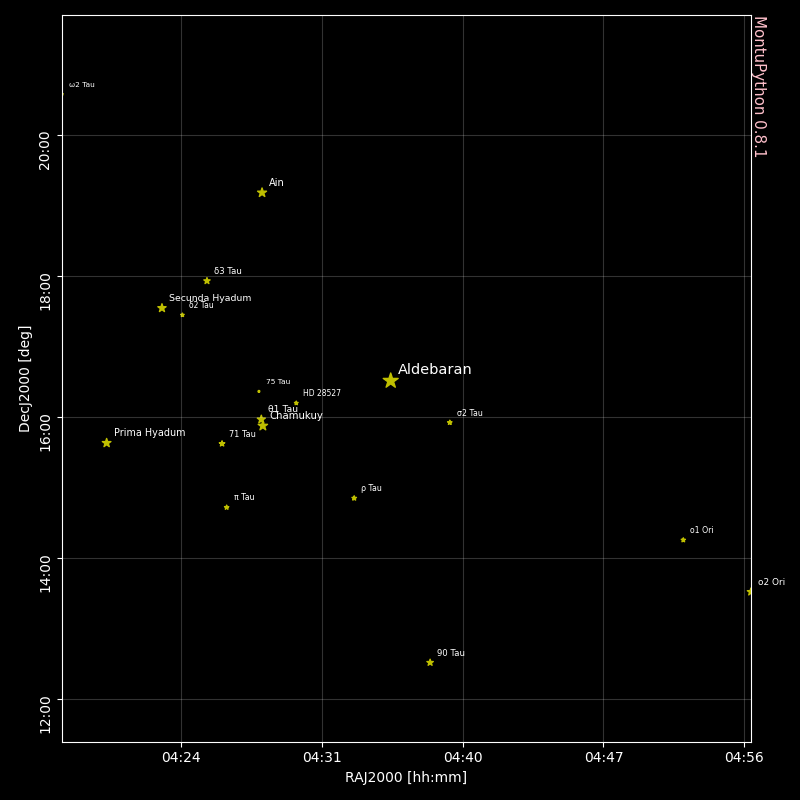Montu Python: astronomical ephemerides for the ancient world
Project description
Montu Python /mnṯw ꜥꜣpp(y)/
Astronomical ephemerides for the ancient world
MontuPython (transileterated mnṯw ꜥꜣpp(y)) is a Python package intended to compute astronomical ephemerides in the ancient world, thousands of years before present. It was initially designed to compute ephemerides for the ancient Egypt, but it can also be used to study astronomical phenomena in other sites of interest for cultural astronomy (archeoastronomy).
Download and install
Describe here how the package can be downloaded and install it in different arquitectures.
If you are using PyPI installation it's as simple as:
pip install montu
Quick start
In this section you should provide the most simple instructions to use your package.
For instance:
from montu import *
or for a safe import:
import montu as mn
Basic code examples
A Google Colab notebook with some basic commands are available here.
In order to properly use MontuPython you need to import the package:
from montu import *
Importing the package will also load some basic data required for calculations, including a complete database with the brightest stars.
Get an historical date in all calendars and scales
One of the most interesting and basic functionalities of MontuPython is to convert date among different type of calendars and astronomical scales. You may taste these functionalities using:
mtime = MonTime('2501 b.c.e. 01-01 12:00:00')
other alternative formats for the same date are:
mtime = MonTime('bce2501-01-01 12:00:00')
mtime = MonTime('-2500-01-01 12:00:00')
whose output will be:
Montu Time Object:
--------------------------
Date in proleptic UTC: -2500-01-01 12:00:00.0000
Date in mixed UTC: -2500-01-22 12:00:00:
Date in SPICE format: 2501 B.C. 01-01 12:00:00.00
General:
Components: [-1, 2500, 1, 1, 12, 0, 0, 0]
Is bce: True
Is Julian: True
Uniform scales:
Terrestrial time:
tt: -142006202700.32004
jtd: 807954.6909685181
UTC time:
et: -142006262400.00003
jed: 807953.9999999997
Delta-t = TT - UTC = 59699.68000000001
Objects:
Date in datetime64 format: -2500-01-01T12:00:00.000000
Date in PyPlanet Epoch: 807953.9999999997
Date in PyEphem Epoch: -2501/1/22 12:00:00
Date in AstroPy Time: 807954.6909685181
Astronomical properties at Epoch:
True obliquity of ecliptic: 23:58:33.587
True nutation longitude: 00:00:10.214
Greenwhich Meridian Sidereal Time: 18:40:25.323
Notice that the date in Gregorian proleptic will be bce2501-01-01 but in mixed calendar will be bce 2501-01-22.
Position of mars at an historical date and place
For this we need to load precision information about the planets using:
Montu.load_kernels(PRECISION_KERNELS)
NOTE: Precision kernels are binary files used by the NASA NAIF SPICE information system which is used by
MontuPythonto calculate with the highest precision the position of the planets in the present and in the past. Some of them are large files (in the order of Giga bytes) so you need enough space to download them.
First we need to prepare some basic objects, the Earth (where the observer is), the location on Earth, the time of observation and the object to be observed:
earth = PlanetaryBody('Earth')
tebas = ObservingSite(planet=earth,lon=33,lat=24,height=0)
mtime = MonTime('-2500-01-01 12:00:00')
mars = PlanetaryBody('Mars')
Now we can ask for the position of Mars:
mars.calculate_sky_position(mtime,tebas)
The result will be:
Computing position of body 'mars' at epoch: jtd = 807954.6909685181
Method 'SPICE':
Position Epoch: prolectic gregorian -2500-01-01 12:00:00.0000, JED = 807953.9999999997
Coordinates @ J2000:
Equatorial: 12:31:48.754 01:37:12.184
Ecliptic: 186:39:46.949 04:38:36.308
Coordinates @ Epoch :
Equatorial: 08:32:9.796 24:06:28.555
Ecliptic: 124:21:21.542 04:39:5.339
Observing conditions:
Distance to site [au]: 0.6604503488431318
Distance to sun [au]: 1.6261149729988635
Solar elongation [deg]: 157:49:18.876
Phase angle [deg]: 13:21:31.981
Magnitude: -1.1
Other properties:
Local true sidereal time: 20:52:25.323
Hour angle @ Epoch: 12:20:15.527
Local coordinates @ Epoch: 06:11:24.275 -41:38:31.094
There are different methods to calculate the position of a planets with MontuPython. You can try all of them:
mars.calculate_sky_position(mtime,tebas,method='all')
NOTE: Some methods depend on the availability of a network connection.
The result of the previous command will be:
Computing position of body 'mars' at epoch: jtd = 807954.6909685181
Method 'Horizons':
Position Epoch: prolectic gregorian -2500-01-01 12:00:00.0000, JED = 807953.9999999997
Coordinates @ J2000:
Equatorial: 12:31:49.147 01:37:6.708
Ecliptic: 186:39:54.558 04:38:33.609
Coordinates @ Epoch :
Equatorial: 08:32:9.283 24:06:29.556
Ecliptic: 124:21:14.472 04:39:4.619
Observing conditions:
Distance to site [au]: 0.66052182424896
Distance to sun [au]: 1.626124866723
Solar elongation [deg]: 157:47:51.000
Phase angle [deg]: 13:22:14.880
Magnitude: -1.1
Other properties:
Local true sidereal time: 20:52:25.323
Hour angle @ Epoch: 12:20:16.054
Local coordinates @ Epoch: 06:11:33.727 -41:38:29.317
Method 'VSOP87':
Position Epoch: prolectic gregorian -2500-01-01 12:00:00.0000, JED = 807953.9999999997
Coordinates @ J2000:
Equatorial: 12:31:48.360 01:37:33.109
Ecliptic: 186:39:33.205 04:38:53.193
Coordinates @ Epoch :
Equatorial: 08:32:9.718 24:06:40.920
Ecliptic: 124:21:17.390 04:39:17.040
Observing conditions:
Distance to site [au]: 0.6604883074760437
Distance to sun [au]: 1.626107096672058
Solar elongation [deg]: 157:49:6.094
Phase angle [deg]: 13:21:48.632
Magnitude: -1.13
Other properties:
Local true sidereal time: 20:52:25.323
Hour angle @ Epoch: 12:20:15.604
Local coordinates @ Epoch: 06:11:23.906 -41:38:18.685
Method 'SPICE':
Position Epoch: prolectic gregorian -2500-01-01 12:00:00.0000, JED = 807953.9999999997
Coordinates @ J2000:
Equatorial: 12:31:48.754 01:37:12.184
Ecliptic: 186:39:46.949 04:38:36.308
Coordinates @ Epoch :
Equatorial: 08:32:9.796 24:06:28.555
Ecliptic: 124:21:21.542 04:39:5.339
Observing conditions:
Distance to site [au]: 0.6604503488431318
Distance to sun [au]: 1.6261149729988635
Solar elongation [deg]: 157:49:18.876
Phase angle [deg]: 13:21:31.981
Magnitude: -1.1
Other properties:
Local true sidereal time: 20:52:25.323
Hour angle @ Epoch: 12:20:15.527
Local coordinates @ Epoch: 06:11:24.275 -41:38:31.094
Create a map of the sky
Now we want to create a map of the sky surrounding Aldebaran. For that purpose we get first the information about Aldebaran:
aldebaran = allstars.get_stars(ProperName='Aldebaran')
Now we select all stars between magnitude -1 and 5 around Aldebaran in a radius of 10 degrees:
hyades = allstars.get_stars_area(RA=aldebaran.data.RA,Dec=aldebaran.data.Dec,radius=10,Mag=[-1,5])
Plot the selected stars:
fig,ax = hyades.plot_stars(pad=0.0,labels=False,figargs=dict(figsize=(8,8)))
The resulting figure will be:
Advanced examples
For a fully-fledged working example see examples/montunctions.ipynb.
What's new
Versions 0.6.*:
- Refactor of MonTime class.
- Corrected a problem with tt during the years 300-1582.
- General cleaning of the package.
- Kernels are separated into basic kernels (which are automatically loaded).
- Julian day dates are rounded-up to 7 figures to avoid representation artifacts.
- Package now load ALL_STARS from import.
Versions 0.5.*:
- New properties (distances, phase angle, magnituded) added to PlanetaryBody class method.
- Solved the DEBUG problem.
- First fully-fledge working script, yay!
- MonTime class is now able to produce dates in all relevant calendars and formats.
- Verified ephemerides calculations for planets.
- Major improvements of all functionalities.
Version 0.1.*:
- First classes created and tested with study case.
- A proper identifying image of the project has been found.
- The project is started!
This package has been designed and written by Jorge I. Zuluaga with the historical advise of egyptologist Francisco "Tito" Vivas (C) 2023
Project details
Release history Release notifications | RSS feed
Download files
Download the file for your platform. If you're not sure which to choose, learn more about installing packages.
Source Distribution
Built Distribution
File details
Details for the file montu-0.6.7.tar.gz.
File metadata
- Download URL: montu-0.6.7.tar.gz
- Upload date:
- Size: 3.9 MB
- Tags: Source
- Uploaded using Trusted Publishing? No
- Uploaded via: twine/4.0.0 CPython/3.9.7
File hashes
| Algorithm | Hash digest | |
|---|---|---|
| SHA256 | f6354b1c0620f4a8dda31ff33aac4b01fc2fea086b3e37e84c9da6910c103bb2 |
|
| MD5 | c63f34d2d8dcbe174819ceabe4513d40 |
|
| BLAKE2b-256 | 25da788fc61e8e82d67ceaf775655a0c9aa175bd6b3ccb54d15bbdccbad78eac |
File details
Details for the file montu-0.6.7-py3-none-any.whl.
File metadata
- Download URL: montu-0.6.7-py3-none-any.whl
- Upload date:
- Size: 3.9 MB
- Tags: Python 3
- Uploaded using Trusted Publishing? No
- Uploaded via: twine/4.0.0 CPython/3.9.7
File hashes
| Algorithm | Hash digest | |
|---|---|---|
| SHA256 | acfced3749e991661ade2ece906d8c9c732a2dd459cda719398cb892dab42ac8 |
|
| MD5 | ed5d0f998aeae6f79e73a2318c60ca46 |
|
| BLAKE2b-256 | 6c735f1c43aedb934f0efa750d770c253098617b62d324ceb561cb010fe6a3d9 |















